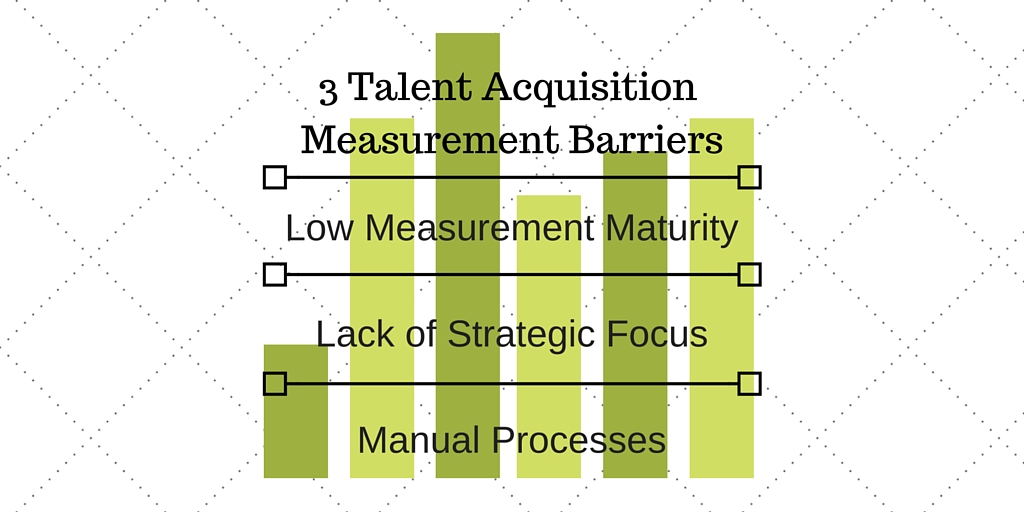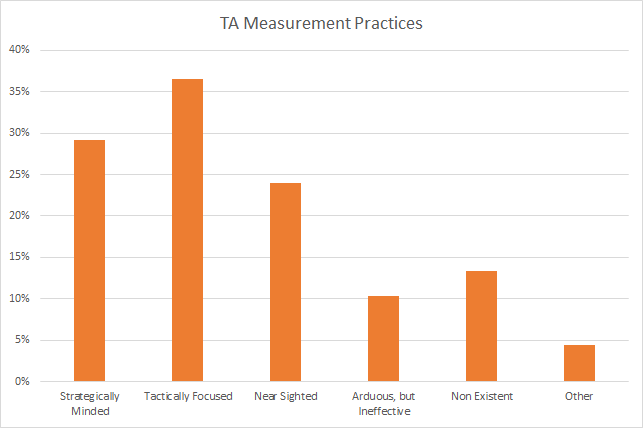Note: I have an upcoming report detailing these issues in more detail and would love to send it to you. Just sign up here to receive your own copy of the research report The Modern Measures of Success in Talent Acquisition. Thanks!
Today, more is demanded of the talent acquisition function than ever before. It is no longer enough to source, interview, and select candidates. Recruiters and talent leaders must mind the candidate experience, build a powerful employer brand, and create partnerships with technology and service providers to drive the overall processes. Recently we looked at Talent Acquisition Measurement Priorities and KPIs, but today I want to examine three overarching trends that are keeping talent acquisition measurement practices from advancing.
Low Measurement Maturity
Simply put, the comfort level with measurement, data, and developing action plans is not where it should be for talent acquisition leaders. Many of the discussions I have with corporate leaders and vendors lead to the same conclusion: many TA professionals are still trying to get their arms around the data and measurement piece of the puzzle.
The research bears this out. A whopping 20% of companies are not tracking some of the key areas of talent acquisition. When we look at the most mature measurement practices where companies are evaluating performance data in real time with frequent reporting, we are seeing fewer than 10% of companies in this range.
Tactical, Near-Term Focus
A whopping 61% of organizations identified themselves as either near-sighted or tactically focused in their talent acquisition measurement practices. In the chart below you can see that fewer than one in three companies see themselves as strategic when it comes to measuring talent acquisition performance.
This sort of approach leads to the “fighting fires” mindset, where there is little to no planning and preparation for how to improve existing hiring practices. The key part of data-gathering is not the gathering, it’s the action after the fact. Without a strategic mindset it’s challenging to have an impact through measurement.
Hands-On Processes
The technologies and tools at our disposal today are incredibly powerful, especially when it comes to generating and analyzing data. And yet when we look at how this is working for companies, more than half of talent acquisition leaders say they are using manual processes to gather, report, and analyze performance data.
Hint: this is not optimal.
When you factor in the potential issues with manually analyzing data, it just doesn’t make sense. Maybe you could have justified it ten years ago when reporting from many recruiting systems were still immature, but today’s talent acquisition technology is much more sophisticated and can provide a clearer picture of performance.
The perfect option, of course, is integration of your data sources. Having each of your systems and platforms connected and sharing bidirectional data is the best outcome for having a clear picture of the data, but just 16% of companies are currently at that level of integration.
Again, this is just a preview of the trends I will be exploring more in-depth in the coming research report. I’d love to send you a copy if you sign up here. Thanks!

Ben Eubanks is the Chief Research Officer at Lighthouse Research & Advisory. He is an author, speaker, and researcher with a passion for telling stories and making complex topics easy to understand.
His latest book Talent Scarcity answers the question every business leader has asked in recent years: “Where are all the people, and how do we get them back to work?” It shares practical and strategic recruiting and retention ideas and case studies for every employer.
His first book, Artificial Intelligence for HR, is the world’s most-cited resource on AI applications for hiring, development, and employee experience.
Ben has more than 10 years of experience both as an HR/recruiting executive as well as a researcher on workplace topics. His work is practical, relevant, and valued by practitioners from F100 firms to SMB organizations across the globe.
He has spoken to tens of thousands of HR professionals across the globe and enjoys sharing about technology, talent practices, and more. His speaking credits include the SHRM Annual Conference, Seminarium International, PeopleMatters Dubai and India, and over 100 other notable events.


